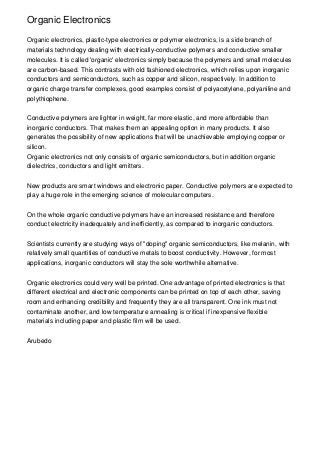
Organic Electronics
- 1. Organic Electronics Organic electronics, plastic-type electronics or polymer electronics, is a side branch of materials technology dealing with electrically-conductive polymers and conductive smaller molecules. It is called 'organic' electronics simply because the polymers and small molecules are carbon-based. This contrasts with old fashioned electronics, which relies upon inorganic conductors and semiconductors, such as copper and silicon, respectively. In addition to organic charge transfer complexes, good examples consist of polyacetylene, polyaniline and polythiophene. Conductive polymers are lighter in weight, far more elastic, and more affordable than inorganic conductors. That makes them an appealing option in many products. It also generates the possibility of new applications that will be unachievable employing copper or silicon. Organic electronics not only consists of organic semiconductors, but in addition organic dielectrics, conductors and light emitters. New products are smart windows and electronic paper. Conductive polymers are expected to play a huge role in the emerging science of molecular computers. On the whole organic conductive polymers have an increased resistance and therefore conduct electricity inadequately and inefficiently, as compared to inorganic conductors. Scientists currently are studying ways of "doping" organic semiconductors, like melanin, with relatively small quantities of conductive metals to boost conductivity. However, for most applications, inorganic conductors will stay the sole worthwhile alternative. Organic electronics could very well be printed. One advantage of printed electronics is that different electrical and electronic components can be printed on top of each other, saving room and enhancing credibility and frequently they are all transparent. One ink must not contaminate another, and low temperature annealing is critical if inexpensive flexible materials including paper and plastic film will be used. Arubedo